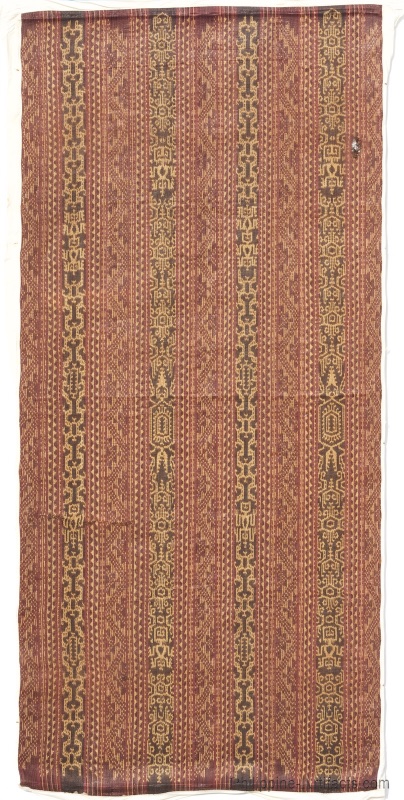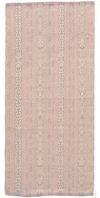| |
 |
|
161  An abaca textile from the Blaan tribal group of Mindanao, with an intricate ikat design of anthropomorphic and other figures, 133 cm long and 62 cm wide. The stylized and abstract designs of human and animal figures of crocodiles and frogs are fascinating and include a variety of heads of human or spirit figures. Look for a pair of eyes on the outside edges of the black and white columns, then a nose in between with a snout or flaring nostrils and a mouth below that, and sometimes a human body below that, other times just the head. The figures are often hidden in the pattern and easily overlooked by those not initiated or acquainted with these ancient forms of graphic code. Do they represent ancestor spirits, or guardian spirits, or threatening spirits? Often the weavers are not even sure anymore; but they remember that these were the traditional designs for heirloom ikat textiles that have been passed down for many generations. (See From the Rainbow's Varied Hue, Textiles of the Southern Philippines, by Hamilton, 1998, fig. 1.39 and 2.25 for similar Blaan textiles). Ikat textile designs of this type were also traditional among the Dayak in Borneo and in other regions of SE Asia, and they managed to resist the encroachments of modern civilization and the vigilance of Catholic and Muslim priests in stamping out all pagan customs related to spirit worship, due to the remoteness of these tribal communities and the obscurity of their sacred images. An abaca textile from the Blaan tribal group of Mindanao, with an intricate ikat design of anthropomorphic and other figures, 133 cm long and 62 cm wide. The stylized and abstract designs of human and animal figures of crocodiles and frogs are fascinating and include a variety of heads of human or spirit figures. Look for a pair of eyes on the outside edges of the black and white columns, then a nose in between with a snout or flaring nostrils and a mouth below that, and sometimes a human body below that, other times just the head. The figures are often hidden in the pattern and easily overlooked by those not initiated or acquainted with these ancient forms of graphic code. Do they represent ancestor spirits, or guardian spirits, or threatening spirits? Often the weavers are not even sure anymore; but they remember that these were the traditional designs for heirloom ikat textiles that have been passed down for many generations. (See From the Rainbow's Varied Hue, Textiles of the Southern Philippines, by Hamilton, 1998, fig. 1.39 and 2.25 for similar Blaan textiles). Ikat textile designs of this type were also traditional among the Dayak in Borneo and in other regions of SE Asia, and they managed to resist the encroachments of modern civilization and the vigilance of Catholic and Muslim priests in stamping out all pagan customs related to spirit worship, due to the remoteness of these tribal communities and the obscurity of their sacred images.



|
|

